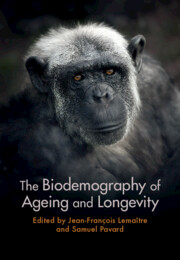Book contents
- The Biodemography of Ageing and Longevity
- The Biodemography of Ageing and Longevity
- Copyright page
- Dedication
- Contents
- Contributors
- Foreword
- Acknowledgements
- 1 The Eternal Youth of Ageing Research
- 2 Theories of Ageing across Ages
- 3 The Diversity of Longevity Metrics
- 4 The Meaning of ‘Exceptional Longevity’
- 5 The Inevitability of Senescence
- 6 The Untapped Potential of Zoo and Aquarium Data for the Comparative Biology of Ageing
- 7 Perspectives in Comparative Biology of Ageing
- 8 An Integrative Approach to Understanding Variation in the Form, Pattern and Pace of Ageing
- 9 Sex Differences in Lifespan, Ageing and Health in the Living World
- 10 Evolution of Human Reproduction, Ageing and Longevity
- 11 Lifespan and Mortality in Hunter-Gatherer and Other Subsistence Populations
- 12 Longevity in Modern Populations
- 13 Health Transition and Population Ageing
- 14 Limit of Human Longevity
- 15 Mortality Modelling at the Oldest Ages in Human Populations
- 16 Lessons from Exceptionally Long-Lived Individuals and Long-Living Families
- 17 Human Populations with Extreme Longevities
- 18 Socio-Economic Consequences of Increased Longevity in Contemporary Populations
- Index
- References
12 - Longevity in Modern Populations
Published online by Cambridge University Press: 14 November 2024
- The Biodemography of Ageing and Longevity
- The Biodemography of Ageing and Longevity
- Copyright page
- Dedication
- Contents
- Contributors
- Foreword
- Acknowledgements
- 1 The Eternal Youth of Ageing Research
- 2 Theories of Ageing across Ages
- 3 The Diversity of Longevity Metrics
- 4 The Meaning of ‘Exceptional Longevity’
- 5 The Inevitability of Senescence
- 6 The Untapped Potential of Zoo and Aquarium Data for the Comparative Biology of Ageing
- 7 Perspectives in Comparative Biology of Ageing
- 8 An Integrative Approach to Understanding Variation in the Form, Pattern and Pace of Ageing
- 9 Sex Differences in Lifespan, Ageing and Health in the Living World
- 10 Evolution of Human Reproduction, Ageing and Longevity
- 11 Lifespan and Mortality in Hunter-Gatherer and Other Subsistence Populations
- 12 Longevity in Modern Populations
- 13 Health Transition and Population Ageing
- 14 Limit of Human Longevity
- 15 Mortality Modelling at the Oldest Ages in Human Populations
- 16 Lessons from Exceptionally Long-Lived Individuals and Long-Living Families
- 17 Human Populations with Extreme Longevities
- 18 Socio-Economic Consequences of Increased Longevity in Contemporary Populations
- Index
- References
Summary
Humans live longer today than ever before. The remarkable rise in longevity occurred in a brief period of human history, roughly since the eighteenth century, and was driven by persistent efforts against epidemics, famines, health insecurity and chronic diseases. This chapter covers essential concepts regarding this extraordinary achievement for the human race, such as the demographic transition model, distinguishable from the earlier Neolithic demographic transition, which both led in their unique way to substantial alterations in the cause and age distribution of deaths. To account for the shift in disease patterns over time, the concept of epidemiological transition was originally proposed by Abdel Omran in the early 1970s and later evolved into broader conceptual frameworks, including the health transition. The chapter concludes by briefly addressing whether increased human longevity is matched by improved health and its future sustainability.
Keywords
- Type
- Chapter
- Information
- The Biodemography of Ageing and Longevity , pp. 239 - 252Publisher: Cambridge University PressPrint publication year: 2024

